-
-
-
|
-
French Polynesia Map
Tahiti Map
-
|
-
-
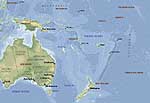
-
-
-
Map of
-
the Pacific
-
|
-
-
-
|
- latest picture taken: September 15, 2009
- click a picture to see details
|
-
-
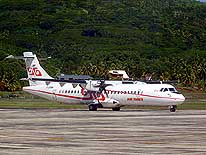
|
-
-
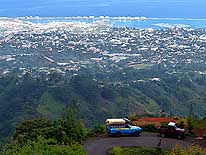
|
-
-
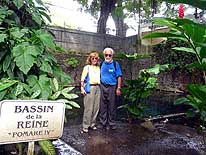
|
- 01
Coming from the Cook Islands,
- we land on August 11th, 2009, 2.30pm
- with Air Tahiti in Papeete. Compared
- to the price, its in-flight service was so-so
|
- 02
We enjoy the view over Papeete,
- the capital of French Polynesia, from
- the nearly 2’000ft. high Belvédère
- lookout (Fare Rau-Ape)
|
- 03
Liliana and Emil pose for a picture
- at the Basin of Queen Tomare IV in the
- “Assembly Park” (Assemblée de la
- Polynésie française) in downtown Papeete
|
-
- Who does not associate the name “Tahiti” with romance? To whom does this
island not conjure up longings and dreams? Who does not identify it with paradise on
earth? When on August 12th, 2009, we enter the office of our shipping agent – the
“Swire Shipping Agencies” in Papeete – and are greeted cordially by
Thierry, the young managing director, we are full of pleasant anticipation. He is
representing the freighter line “Greater Bali Hai”, which transported our
containerized car since Vanuatu across the Pacific (Fiji – Samoa / American Samoa –
Tahiti and on to Tonga). Finally our long cherished dream to
visit the heart of Polynesia with our LandCruiser is coming true. After all, we have the
written agreement from the customs authorities in our hands that they will accept our
Carnet de Passage. We are convinced that nothing should go wrong. Indeed, customs
clearance is a breeze, and when afterwards we are sent to the traffic department, we think
it to be a mere formality issue.
|
-
-
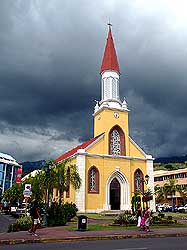
|
-
-
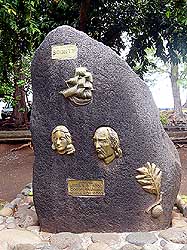
|
-
-
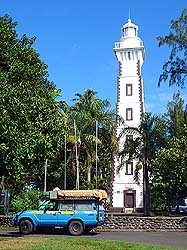
|
- 04
Thunderclouds accumulate
- behind the Catholic Cathedral
- (Cathédrale Notre-Dame de
- Papeete) in the heart of Papeete
|
- 05
A monument commemorates
- the Mutiny on the „HMS Bounty“
- at “Point Venus” in the Mataval
- Bay near Mahina
|
- 06
The lighthouse at “Point Venus“
- was designed by the father of the
- Scottish author Robert Louis Stevenson.
- RLS, who died 1894 in Samoa,
- worked in summer 1866 in the
- office of his father in Papeete
|
-
- How wrong can one be! When we sit across from the responsible office lady named Cecile,
Thierry – who is coming unselfishly along with us through the whole red tape –
suddenly also makes a troubled face when he hears the conditions for our LandCruiser to be
allowed to circulate on Tahiti’s roads. Taking as a model the case of a Chinese
consul, who brought in 2002 his car for six months to work on the island, she asks for a
normal registration procedure too, with all the bells and whistles, which includes also a
tax of CFP 2000 per day (= more than US$23!). Intending to stay three months on the
islands, this would add up incredibly. Is Tahiti, the place of our dreams, ending up in
smoke at the very last moment? Because one thing is clear: It is impossible for us to
fulfill the requirements to adjust our car to French Polynesia’s own local
specifications. Therefore, if no miracle occurs, we will have to divert our container with
a heavy heart on “Greater Bali Hai’s” next vessel to a new destination.
Where this would be, we still would have to decide.
|
-
-
-
-
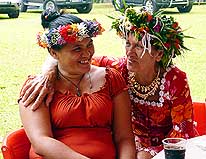
|
-
-
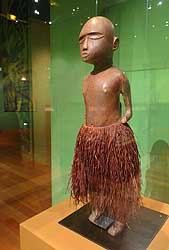
|
-
-
-
-
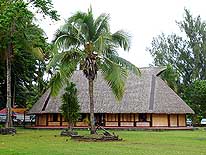
|
- 07
Spreading happiness: Two
- Tahitians wearing traditional hand
- woven girdles of fresh flowers
|
- 08
“Tiki”in the «Musée de Tahiti
- et des Îles». Tikis are sacred
- sculptures in Polynesian culture
|
- 09
The souvenir shop at “Point
- Venus“ near Mahina is built
- the traditional way
|
-
- Yes, and once more one of the incredible coincidences occur that have come to our rescue
more than once on our long journey – we can hardly believe it: Due to the lack of
campsites in Tahiti, we surfed in the internet during our 9-day-stopover in Rarotonga on
the Cook-Islands for an affordable accommodation – not
an easy task in one of the most expensive parts of the world – and we found Astrid’s family place in Mahina, 6 miles
north of the capital Papeete. Though the price of CFP 6000 (= US$70) per night for her
bungalow with a separate entrance is hefty, for Tahiti it is considered cheap, unless one
is prepared to sleep somewhere in a dormitory. We booked for two nights hoping to have by
then the car released from the port.
|
-
-
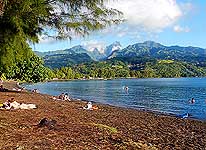
|
-
-
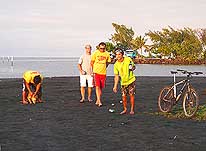
|
-
-
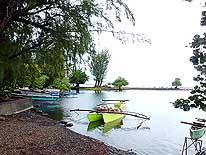
|
- 10
Public beach of black volcanic
- sand at “Point Venus“ near Mahina
|
- 11
Enjoying a game called
- “Petanque“ at “Point Venus“
|
- 12
A peaceful picture: A loaded
- outrigger and canoes tied-up
- at “Point Venus“ near Mahina
|
-
- Our choice turns out to be the biggest lucky strike at all. Not only are our hosts very
nice, we also like our bungalow with own bathroom, decorated lovingly with Polynesian
decor, an open sea view and the tropical plants surrounding it. What turns out to be a
real asset however for us is that Astrid and her husband Marc know also a member of
parliament: The President of the Commission for International Affairs, Catherine
Tuiho-Buillard. On Thursday evening, when the negotiations with the traffic department
seem to go totally out of control, they contact her. Friday morning – we are just
having breakfast – Astrid calls us excitedly: “The problem is solved, the
Minister of Transport has given the OK, I just got a phone call from Catherine”
– what a great boost!
|
-
-
-
-

|
-
-
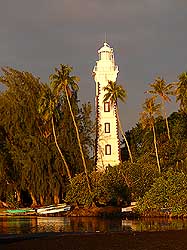
|
-
-
-
-
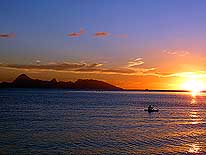
|
- 13
|
- 14
|
- 15
|
- The setting sun adds a special charm to ”Point Venus”
|
-
- It is astonishing how again and again we happen to meet the right people at the right
time who are then also spontaneously willing to help us. “The angels seem to watch
tremendously over us”. Yes, there are really many terribly nice people all over the
world! To cut an already long story short: Astrid is driving us immediately to Mrs. Cecile
at the road traffic department (STT - Service de Transports Terrestres) who turns out to
be a lot more cooperative in allowing us now to drive out of the port. Next week, we ought
to purchase a local license plate, she instructs us, while still not letting us off the
hook. We then would receive the “grey card”. When she wants us to surrender our
original vehicle license (title) in exchange, we refuse simply and she does not insist any
further. At the end, somehow the whole matter fizzles out and we keep our Swiss license
plates.
|
-
-
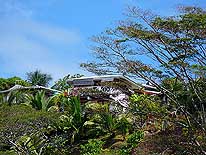
|
-
-
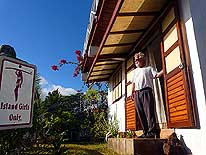
|
-
-

|
- 16
The setting of our bungalow on
- a hilltop in Mahina, surrounded by
- tropical greenery and a lovely
- ocean view is perfect .....
|
- 17
..... Emil at its entrance
- enjoying the panorama .....
|
- 18
..... and the breakfast with
- different cheeses is waiting
|
-
- One hour after leaving her office we are with the help of Thierry at the port to release
our “best travel buddy” from its 16th cage. What a great relief again to find
our LandCruiser once more unharmed, when they open the container. This time, we were not
so sure about it, because heavy damages on the container itself show that it must have
gone through really rough times. Shortly afterwards, the port gate opens and we joyfully
drive out: In our 25th year of traveling, we
finally reached the island of our dreams: Three beautiful months of discovering French
Polynesia are now lying ahead!
|
-
-
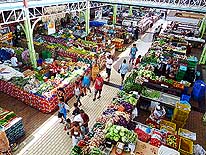
|
-
-

|
-
-
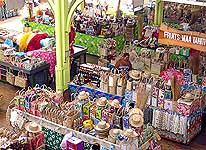
|
- 19
Below the roof of the bright and
- breezy Papeete market hall everything
- is put up for sale: Exotic flowers, fresh
- meet, pastries and vegetable .....
|
- 20
..... papaya, banana,
- pineapple .....
|
- 21
..... hand woven straw hats and
- bags as well as traditional craftwork.
- At many stalls however, currently
- the buyers, i.e. tourists are missing
|
-
- At the first ATM, a little bit of our euphoria evaporates. We can only cash 30’000
CFP (= US$350) and learn that the Maestro Card remains now blocked for the six following
days, at least for cash withdrawals! Really strange! With this small amount, we are not
going far, all the more that alone the port charges for our container is already
60’000CFP (= US$700). And, of course, we cannot pay our private accommodation with
credit cards, because none is accepted. Getting cash becomes a real problem. Obviously it
is assumed that the rich tourist pays everything by plastic, hence there is no need for
cash. After a long search, Banque de Polynesie gives us CFP 100’000 (= US$1’165)
with our Visa card at the counter, but again the card remains unusable for the following
six days. When, after expiration of this term, we want to cash again the same amount, it
does not work anymore at all. In an unfriendly manner, we are told that we have to check
with our bank, and then nobody is taking care of the matter any longer – service is a
foreign word. The tourist office, where we complain about the lack of customer service and
the complexity of the problem of getting cash, sends us to the head office of the same
bank. Interestingly it starts functioning again. This tourist unfriendly banking system
and the lack of interest in assisting are really upsetting us. Surely this does not help
either to revive Tahiti’s current 30% decline in the tourism sector.
|
-
-
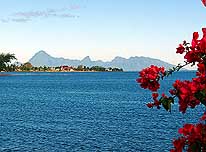
|
-
-
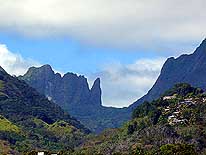
|
-
-
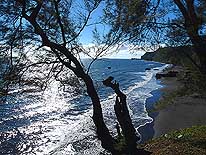
|
- 22
The island of Moorea, the
- jewel of French Polynesia,
- is looming across the sea
|
- 23
A crown with majestic mountain
- towers in the interior of Tahiti:
- Mt. Te Tara O Maiao,
- called Diadème (4.334ft. high)
|
- 24
The North coast at Pt. Tapahi
- is dotted with small beaches
- of black volcanic sand
|
-
- But the initial difficulties are soon forgotten and the charm of Tahiti takes more and
more possession of us: The bizarre mountain peaks, the dense jungle, the exotic flowers
and colorfully blooming trees, the women with a fresh Tiare blossom tucked behind their
ear or even a floral wreath (lei) on their head, the peaceful Polynesian way of life. We
cannot blame the men of the “Bounty” who mutinied against captain William Bligh
as he forced them to leave this “paradise”. Each morning, when we open the door
of our rented bungalow, we enjoy the white-yellow Frangipani flowers, the deep read and
purple Bougainvilleas, the rustling palm leaves, the wide view to the open ocean and the
presence of the brown-beige finches that settle in swarms on a Bougainvillea branch beside
our breakfast table. And a mere five minutes drive away is “Point Venus”at
Mahina’s Matavai Bay, where we love to spend the evenings on the black sandy beach
and watch the sun set besides the razor-sharp mountain scenery of Moorea, the sister island. “Point Venus” is not only
a favorite place for locals to swim, sunbath, surf, picnic, play “Pétanque”
(Boggia), practice canoe racing or take their dogs for a walk. It is also a place, where
history was written.
|
-
-
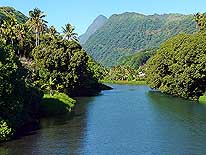
|
-
-
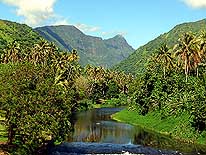
|
-
-
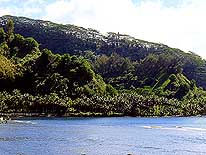
|
- Luxury tropical vegetation and narrow lush green and steep valleys, topped by dramatic
mountain peaks is the scenery,
- which shapes the picture of Tahiti and fascinates us
|
- 25
Valley of Papenoo
|
- 26
Tahaute Valley at Mahaena
|
- 27
At the East coast, about halfway
- between Hitiaa and Faaone
|
-
- The name of this small peninsula was given by Capt. James Cook, who in 1769 built an
observatory to monitor the transit of Venus across the face of the sun in an attempt to
calculate the distance between the sun and the earth. On March 4th, 1797, the first
members of the “London Missionary Society” put foot on this small headland, and
lately a monument was erected to commemorate the legendary “Mutiny on the
Bounty”, whose task it was to bring breadfruit seedlings from Tahiti to the British West Indies as a food source for the African
slaves working on the British plantations. The still working white lighthouse – the
only in Tahiti - was designed by Thomas Stevenson, the father of the Scottish author
Robert Louis Stevenson, who died in Samoa. It adds to the
special charm of this attractive corner.
|
-
-
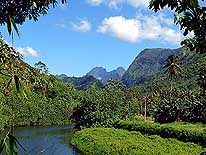
|
-
-
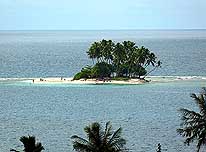
|
-
-
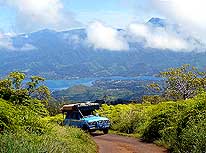
|
- 28
At Tahiti’s East coast nature
- is still widely untouched:
- Papeiha River at Pk 45 (milestone)
|
- 29
A tiny island with palm trees
- and a white sandy beach. Who
- does not dream of it?
- (Motu Nono in the bay of Taravao)
|
- 30
We climb towards the viewing
- plateau of “Tahiti Iti“ (Little Tahiti) -
- the smaller peninsula in the Southeast.
- View towards the main peninsula
- Tahiti Nui (Big Tahiti)
|
-
- Beneath wide blue skies, we start from our peaceful base in Mahina at the North coast in
Southeasterly direction to our first circumnavigation of Tahiti’s main island
“Tahiti Nui”. It has a ring road of only 75 miles and belongs to the Windward
Islands. After having experienced plenty of potholed roads during previous destinations
(particularly in Vanuatu, Fiji
and also Samoa), we have nearly forgotten how smooth roads
can be, allowing also Emil as the permanent driver to enjoy the luxury of the tropical
vegetation and the mountain panorama unique to Tahiti. Narrow lush green and steep
valleys, topped by dramatic mountain peaks, is the scenery that most of all shapes the
picture of Tahiti and most of all fascinates us.
|
-
-
-
-
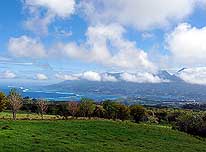
|
-
-
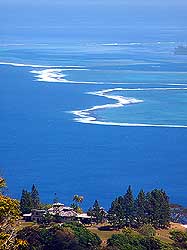
|
-
-
-
-
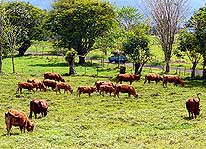
|
- 31
Looking from the viewing platform
- of “Tahiti Iti“ towards the Isthmus of
- Taravao and the mountain panorama
- of the main island “Tahiti Nui“ .....
|
- 32
..... and the turquoise
- shining ocean in the
- South with the reef
|
- 33
Climbing to the Taravao plateau
- on 2’000ft. altitude, we encounter
- an atypical picture of Tahiti:
- A pasture with well fed cows
|
-
- Now and then we pass neat villages, almost hidden behind breadfruit and mango trees and
the richness of exotic flowers and blooming trees. Joggers, cyclists or families on foot
cross us. The encounters are friendly, but a kind of reserved. We miss the bright smiles
that accompanied us in many of the poorer Pacific islands.
The road snakes mostly along the coast and the small sandy beaches invite us to stop and
watch the buzz of activity of the many surfers. Surfing has always been a popular sport in
Polynesia. In comparison to the other Pacific islands, where every inch of land is
privately owned, we enjoy pulling out anywhere without being asked to pay. All the beaches
are public, some offer even showers, toilets and picnic tables – since New Zealand a most welcome amenity.
|
-
-
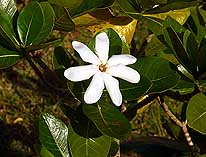
|
-
-
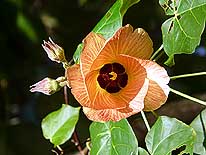
|
-
-
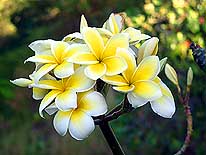
|
- 34
“Tiare Tahiti” is Tahiti’s
- national flower
|
- 35
Tahiti’s flora surprises us
- again and again with new “exotics”
|
- 36
Frangipani is the blossom that
- we also automatically connect with
- the South Pacific. It carries also the
- names of Plumeria respectively Tiare
|
-
- Tahiti has a size of 403½ sq.mi., an elevation of 7’352 ft., a population of
178’000 and consists of two peninsulas: Tahiti Nui (Big Tahiti) and Tahiti Iti
(Little Tahiti). Arriving in Taravao in the southeast of Tahiti Nui, we branch off to
Tahiti Iti that is connected by an isthmus. Considering the beautiful weather, we
spontaneously decide to make a side trip to the Taravao plateau already today, despite
that we intended to save the smaller island, also called “The Near Island”, for
another day. Who knows when the sight will be as clear again (the weather is currently not
at all Pacific-like, but very moody). The narrow road winds up to an altitude of
2’000ft. Suddenly and unexpectedly a familiar sight takes us by surprise: Green
meadows where well fed brown cows munch unhurriedly with their calves, resembling a Swiss
pastoral scene.
|
-
-
-
-
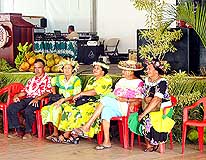
|
-
-
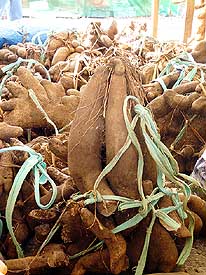
|
-
-
-
-
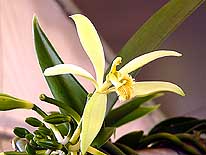
|
- 37
At the Agriculture Show in Faaa,
- the women show up with
- their traditional head dresses .....
|
- 38
..... in the vegetable
- sector the huge yam
- roots catch our eyes .....
|
- 39
..... and in the flower sector
- the delicate blossom of
- the Tahitian Vanilla bush
|
-
- Knobby trees, densely draped with Spanish moss, appear in this cooler climate, which is
beneficial also for the growth of vegetable. We see fields with carefully planted salad
seedlings, fully grown taro (roots) and maize. And amidst them sit mostly simple, but also
some neat farm houses. The panorama from the viewing pavilion offers an imposing sight:
Stretching below us is the Isthmus of Taravao with the turquoise water of the Pacific
Ocean to the South and the deep blue open sea to the East. And in front of us white clouds
sail past the majestic mountain scenery of the bigger island “Tahiti Nui”. A
lonely chicken keeps us company. We know what it is waiting for and fetch the fresh
Baguette that we just bought in Taravao’s supermarket to share it. Wild roosters and
chicken, often with cute chicks, wander around freely everywhere looking for food. They do
not belong to anybody and can be caught by anyone, we are told.
|
-
-
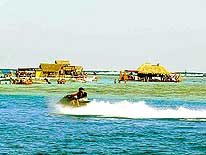
|
-
-
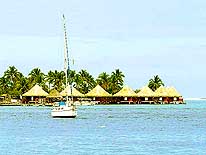
|
-
-
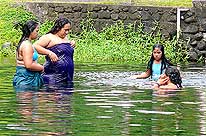
|
- 40
Overwater restaurants are
- popular and crowded on weekends
- in Punaauia on the West coast
|
- 41
The overwater bungalows of
- the Intercontinental (Beachcomber)
- Hotel in Papeete belong to the
- top end accommodations
|
- 42
Enjoying a swim at the wells of
- Vaima in Mataiea at the South coast
|
-
- As soon as we reach the Southwestern side of Tahiti Nui, it becomes obvious that this
coast is more densly populated than the Northeast. Being a Sunday, also many families are
enjoying their day off. From the permanent eateries and from those on wheels, called
“Roulottes”, the smell of grilling and cooking pervades temptingly the air.
Firstly, we stop at the wells of Vaima in Mataiea. It seems to be a place where only
locals bath. They don’t seem to care much that two huge eels share their refreshing
Sunday fun. Quite the contrary: They are feeding them with bread. Paul Gauguin, the French
painter, lived in Mataiea from 1891-1893 with his Polynesian wife Teha’amana in the
hope to find a world far from any civilization. In 1½ years only, he produced 66
paintings. We love his works. Like no others, they express the exotic charm of Polynesia.
|
-
-
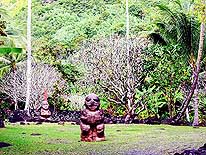
|
-
-
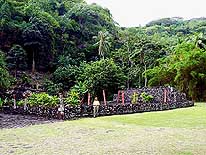
|
-
-
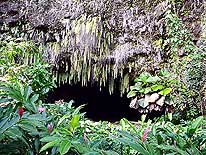
|
- 43
Tiki at the Arahurahu Marae in
- the village of Paea in the Southwest .....
|
- 44
..... a site of worship of ancient
- Polynesia, consisting of a fenced in
- platform of big black volcanic
- stones with an altar
|
- 45
The Vaipoiri grotto in Maraa South
- of Paea in the Southwest: Hanging
- ferns, red and pink ginger and lush
- plants make it look fairytale like
|
-
- Shortly after, we come along the three Maraa grottos. With their hanging ferns and
surrounded by red ginger and vivid green, they look like a fairytale. In a village more to
the North, in Paea, in a forest aisle lies the restored and well maintained Arahurau
Marae. It is a site of worship of ancient Polynesia in a shady forest setting, consisting
of a platform of big black volcanic stones with an altar, fenced in by a low stone fence.
These sacred sites were once scattered around the whole island. Today, most of them
disappeared, either they were destroyed or taken back by the jungle. When we come closer
to the capital of Papeete, more and more of the unattractive settlements – perched on
the mountain slopes – hurt our eyes. They are residencies for the rich, we are told.
We are glad when we leave behind the not unattractive, but always congested city with its
parking problems and are back in our little “oasis” on the hill near Mahina.
|
-
-
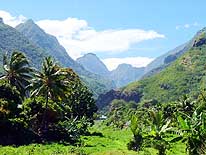
|
-
-
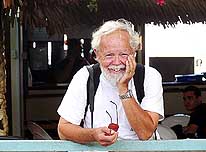
|
-
-
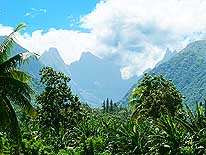
|
- 46
View into the mountains (left in
- the back Mt. Tahiti) of the Orofero
- valley at Paea in the West
|
- 47
Emil, the happy world traveler
|
- 48
Tropical vegetation and mountains
- are the characteristic features of Tahiti.
- The view towards North at the
- South coast near Papara
|
-
- On our island tour, we realized that the police presence is very high and that road
checks are common – by the way a remarkable difference to other Pacific islands, especially Samoa,
where except from Apia, the capital, there is no police in sight. “Is it necessary
here?” we ask ourselves. So far, our LandCruiser is never flagged down. Papeete is a
busy city. The times when it was a dreamy South Pacific settlement are long gone. It is
especially evident at lunch time, when each restaurant chair is taken regardless of the
price. Our hair stand on end while looking at the menu list. Are these European prices we
have no idea of anymore?
|
-
-
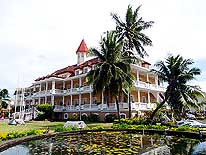
|
-
-
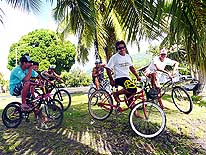
|
-
-
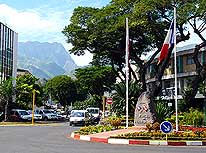
|
- 49
Hotel de Ville (Mairie), Papeete’s
- Town Hall, was built in the architectural
- style of the Palace of Queen Pomare IV
|
- 50
Cyclists make a break
- on their island tour
|
- 51
At the “Place de l’Autonomie“ –
- “autonomous square” – two flags are
- raised: The Tahitian and the French
|
-
- A plate of Spaghetti Bolognaise costs e.g. 1’500 CFP (= US$17.50), a toast with
pâté 1’950 CFP (= US$22.70), a salad 700 CFP (US$8.20). Luckily we can share the
kitchen with our host’s family and cook ourselves. Shopping in Carrefour or Champion
supermarkets and looking there for specials makes it affordable. And after Astrid reduced
the daily rate of our bungalow due to our monthly rate, it becomes acceptable too (instead
of US$70 we pay now US$44 daily). It is familiar but still with personal privacy, neat and
quiet – except when the dogs bark at night – what they unfortunately mostly do!
By chance we are able to receive wireless, what is very helpful for dealing with the
necessary bureaucracy and organization of our continuous Pacific
island hopping.
|
-
-
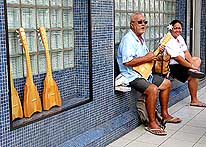
|
-
-
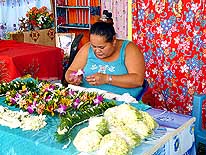
|
-
-
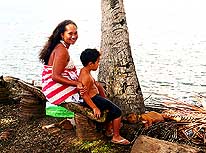
|
- 52
At the market of Papeete a guitar
- seller attracts customers with his songs .....
|
- 53
..... and a women makes
- new garlands from fresh flowers
|
- 54
A Tahitian woman is looking
- out to the open sea with her son
|
-
|
-
- Continuations from Tahiti:
-
-
|
-
|
|
![]()